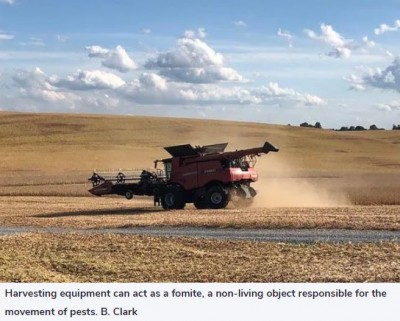Best Management Practices for Field Biosecurity

By Alyssa Collins, Penn State Extension
As producers, we are already familiar with native and exotic crop pests that can cause significant economic losses through reductions in crop or forage yield, impacts on harvestability, impacts on quality, and the costs of inputs required for pest management.
To reduce the likelihood of introducing new pests to the farm, it is recommended that producers develop a biosecurity plan for their operation. Those that have an animal enterprise on the farm are likely already familiar with biosecurity procedures implemented to reduce the spread of animal diseases and pests - the same basic principles can also be applied to our crop and forage fields. Implementation of biosecurity procedures may reduce the likelihood of pest introductions and can limit their potential spread among multiple crops or fields in your operation.
Movement of PestsTransmission methods of pests includes movement via fomites, vectors, other living organisms, air currents, and water movement/irrigation.
Fomite transmission involves the movement of plant diseases or pests by inanimate objects. Planting, tillage, and harvesting equipment would be an example of potential fomites responsible for field to field movement of pests.
In soybeans, the pathogen responsible for white mold forms small, hard lumps of fungus that can be moved from field to field in tire treads, on tillage implements, and even in combines.
Vectors are living organisms (such as insects) that can carry and transmit pathogens to our crops and forages, usually during feeding activity. Other living organisms can also carry pests on their physical form, and these may be introduced incidentally (for example introduction of weed seeds by birds or other wildlife). One of the diseases that affect barley and wheat, barley yellow dwarf, is caused by a virus that is transmitted from infected to healthy plants by aphids when they feed.
Airborne transmission may include the transportation of insects and diseases traveling via air currents. Waterborne transmission can occur due to impacted irrigation sources/equipment or by incidental surface runoff from contaminated fields. Several of the rust diseases that can be found in corn, soybean, and small grain crops move in weather systems from southern regions where the pathogens overwinter to our fields in Pennsylvania.
Plan DevelopmentBiosecurity plan development should involve all farm partners and employees. The plan should be available in writing, understandable to all, and should also be reviewed and updated annually to remain current. Effective plans are utilized by everyone, everyday and enforced to mitigate the potential movement of pests as described above.
General Recommendations- Require all employees and staff to read your biosecurity plan. Make the plan readily available by filing a copy in a known location accessible by all employees and staff.
- Diversify the operation to avoid uniform susceptibility by planting multiple crop species and/or varieties.
- Purchase certified seed free of diseases and weeds.
- Become aware of potential diseases and pests in your region, and scout fields regularly.
- Report any unusual plant diseases or pests to your local Extension educator or to the Pennsylvania Department of Agriculture.
- Post signs advising visitors of biosecure areas, and who to contact for entry permission.
- Limit access of property to certain areas through fencing or gated entry sites.
- Lock gates and buildings when not in use.
- Have designated (preferably paved) areas for vehicles to park that have visited other farms or agricultural sites.
- Vehicles arriving from other agricultural sites should be cleaned before allowing movement into fields. This includes mud and plant debris on vehicles and equipment.
- When traveling from properties with known disease or pest issues you may consider washing your hands, fully showering, and changing clothes. Disposable boot covers or multiple pairs of shoes can limit transmission.
- Consider performing field operations (tillage, spraying, harvesting) in areas with known pest issues only after performing those operations in "clean" fields first, to avoid transmitting any organisms to new fields.
- Properly contain plant material showing unusual symptoms or signs during transportation or mailing.
These best management practices above can be used to develop a biosecurity plan for your operation. Planning will allow you to determine the measures needed to implement a comprehensive biosecurity program to protect your facility and fields in the best way possible. For additional recommendations for developing a biosecurity plan specific to your operation, we encourage you to contact your local Extension educator.
Upcoming Events
WNY Pastureland Conversion & Soil Health Field Day
July 16, 2025
Middleport, NY
Join American Farmland Trust for the Western New York Soil Health Field Day on July 16, 2025, at Zeliff Farm in Middleport, NY, from 9:00 AM-3:15 PM. Learn about pasture conversion, soil health benchmarking, biochar in grazing systems, and best grazing practices. Plus, enjoy hands-on demos with the NY Soil Health Trailer, drones, and cover crops! Check out the attached agenda for more information about the field day and REGISTER HERE. Zeliff Farms is a regenerative beef operation who has recently partnered with AFT on outreach and education to farmers including learning circles and evaluating biochar effects on soil health.
IPM Strategies to Protect Corn and Soybean Seed in NY
July 30, 2025
Hamburg , NY
SWNYDLFC and Cornell IPM are hosting a grower meeting to discuss integrated pest management strategies for protecting corn and soybean seed in New York.
FAMACHA Training for Sheep and Goat producers in Woodhull NY
August 13, 2025 : FAMACHA Training in Woodhull
Woodhull, NY
Join us for a discussion and hands-on training for internal parasite integrated pest management in sheep and goats. Certification is available to all students participating in the workshop.
Announcements
No announcements at this time.





